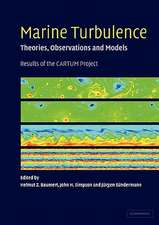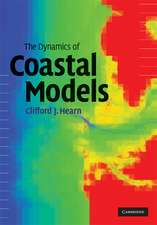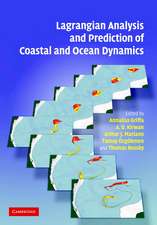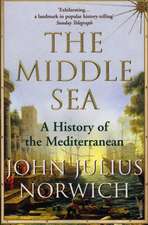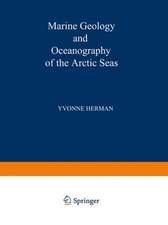Earth’s Rotation from Eons to Days: Proceedings of a Workshop Held at the Centre for Interdisciplinary Research (ZiF) of the University of Bielefeld, FRG. September 26–30, 1988
Editat de Peter Brosche, Jürgen Sündermannen Limba Engleză Paperback – 12 dec 2011
Preț: 641.03 lei
Preț vechi: 754.15 lei
-15% Nou
Puncte Express: 962
Preț estimativ în valută:
122.66€ • 128.39$ • 102.09£
122.66€ • 128.39$ • 102.09£
Carte tipărită la comandă
Livrare economică 31 martie-14 aprilie
Preluare comenzi: 021 569.72.76
Specificații
ISBN-13: 9783642755897
ISBN-10: 3642755895
Pagini: 272
Ilustrații: XV, 255 p. 8 illus.
Dimensiuni: 170 x 242 x 14 mm
Greutate: 0.44 kg
Ediția:Softcover reprint of the original 1st ed. 1990
Editura: Springer Berlin, Heidelberg
Colecția Springer
Locul publicării:Berlin, Heidelberg, Germany
ISBN-10: 3642755895
Pagini: 272
Ilustrații: XV, 255 p. 8 illus.
Dimensiuni: 170 x 242 x 14 mm
Greutate: 0.44 kg
Ediția:Softcover reprint of the original 1st ed. 1990
Editura: Springer Berlin, Heidelberg
Colecția Springer
Locul publicării:Berlin, Heidelberg, Germany
Public țintă
ResearchDescriere
Earth's Rotation from Eons to Days reviews long-term changes, methods of measurement, and the major influences on rotation parameters. In order to understand secular changes, the momentary behavior of ocean tides must be analyzed and appropriately modelled. Researchers and students in astronomy and all fields of geosciences will find a wealth of information related to the interaction of geophysical phenomena and the rotation of the planet Earth.
Cuprins
Earth’s Rotation Measured by VLBI.- 1 Determination of the Earth Rotation Parameters by VLBI.- 1.1 Project IRIS.- 1.2 DSN VLBI Observations at JPL.- 1.3 The GJRO Campaign.- 1.4 The VLBI Campaigns with HartRAO.- 2 Analysis of the Earth Rotation Parameters Observed by VLBI.- 2.1 Analysis of the UT1 Series.- 2.2 Analysis of the IRIS Pole Series.- 3 Relation Between the Fortnightly and Monthly Tidal Variations and the Variations of the Pole?.- 4 Conclusions.- References.- Relativity and the Earth’s Rotation.- 1 Introduction.- 2 Post-Newtonian Effects: Free Rotation of the Earth.- 3 Post-Newtonian Effects: Forced Precession and Nutation.- 4 Relativity Experiments and the Earth’s Rotation.- References.- Astrometric Observations of Hevelius and Derived Values of ?T (Dynamical Time — Universal Time).- 1 Introduction.- 2 The Solar Observations.- 3 The Lunar Observations.- References.- Historical Chinese Astronomical Observations.- 1 Historical Chinese Astronomical Observations (1).- 2 Historical Chinese Astronomical Observations (2).- 2.1 Stars.- 2.2 Special Astronomical Phenomena.- Application of Early Chinese Records of Lunar Occultations and Close Approaches.- 1 Introduction.- 2 Observational Criteria and Method of Analysis.- 3 Data Analysis.- 4 Discussion.- 5 Conclusions.- References.- Ancient Central Eclipse Records of China and Variation of the Earth’s Rotation.- 1 Introduction.- 2 General Principle.- 3 Data Analysis and Results.- 4 Discussion.- References.- Ancient Eclipse Records of East Asia and the Earth’s Rotation.- 1 Introduction.- 2 Valuable Time Records of Eclipses.- 3 Importance of Central Eclipse.- 4 Use of the East Asian Series of Ancient Records.- References.- Tidal Acceleration of the Moon.- References.- The Variation in J2 and in the Moments of Inertia: Satellite Results and Consequences for the Angular Momentum Budget of the Earth-Moon-Sun System.- 1 Introduction.- 2 Recent Values of Quantities Needed for the Angular Momentum Budget.- 2.1 Secular Variation in the Moon’s Mean Motion Due to Tidal Dissipation.- 2.2 Secular Variation in J2 and Related Quantities.- 2.3 Secular. Variations in the Orbital Elements of the Moon’s and Earth’s Orbit Due to Tidal Dissipation.- 3 Secular Tidal Variation in the Orbital Angular Momentum of the Earth-Moon-Sun System.- 4 Secular Tidal Variations in the Angular Velocity of the Earth’s Rotation.- 5 Residuum in the Total Angular Momentum Budget.- 6 Conclusions.- References.- Celestial Mechanics of Present Tidal Friction.- 1 Introduction.- 2 Equations of Motion.- 3 Effect of Gravitational Field.- 4 Earth’s Body Tides.- 5 Ocean Tides.- 6 Effect of Tides on the Motion of Artificial Satellites, Solution of the Inverse Problem: Determination of Tidal Parameters.- 7 Effect of Tides on the Moon’s Motion.- 8 Parameters of Ocean Tides — Satellite Solutions.- 9 Parameters of Body Tides.- 10 Secular Tidal Variation of Parameters of the Moon’s Orbit.- 11 Conclusion.- References.- The Consideration of Solid Earth Effects in Ocean Tide Modeling.- 1 Introduction.- 2 The Computation of Free and Forced Oscillations.- 3 Free and Forced Hemispherical Oscillations.- 4 Near-Resonance Semi-Diurnal Oscillation Systems.- 5 Conclusions.- References.- Variations of the Angular Momentum Budget for Tides of the Present Ocean.- 1 Introduction.- 2 Simulation of Ocean Tides.- 3 The Angular Momentum Budgets.- 4 Variations of the Earth’s Rotation.- 5 Summary and Conclusions.- References.- The Pole Tide and the Damping of the Earth’s Free Nutation.- 1 Introduction.- 2 A Glance at the History.- 2.1 At the Beginning: Klein and Sommerfeld (1910).- 2.2 A Milestone: Bondi and Gold (1955).- 3 A Spherical Harmonic Model of the Pole Tide.- 3.1 The Algorithm.- 3.2 The Comparison with Observed Values.- 4 Some Aspects of the Modern Theory.- 5 Conclusions.- References.- The Seasonal Angular Momentum of the Thermohaline Ocean Circulation.- 1 Introduction.- 2 Calculation of Thermohaline Currents.- 2.1 Basic Equations.- 2.2 Thermal Wind Equations.- 2.3 The Hydrographic Data.- 3 Oceanographic Results.- 3.1 The Global Circulation.- 3.2 Seasonal Variations.- 3.3 Transport Calculations.- 4 Angular Momentum Contained in Thermohaline Currents.- 4.1 Calculations Based on Geostrophic Currents.- 4.2 Calculations Based on a General Circulation Model.- 4.3 Implications for Length of Day.- 5 Conclusions.- References.- Atmospheric Effects on the Earth’s Rotation.- 1 Introduction.- 2 Outline of the Theory of Atmospheric Large-scale Motions.- 3 Internal Friction.- 4 Surface Friction.- 5 Atmospheric Angular Momentum.- 6 Polar Motion.- 7 Solar Gravitational Tidal Torque.- 8 Magnetospheric Friction.- References.- The Solar Torque — A Leak for the Angular Momentum of the Earth-Moon System.- 1 Introduction.- 2 The Ratio.- 2.1 The Schematic View.- 2.2 Periodic Variations.- 2.3 Average Torques.- 3 The Balance.- References.- Tectonic Consequences of the Earth’s Variable Rotation on Geological Time Scales.- 1 Introduction.- 2 Outline of the Theory of Equilibrium Figures.- 3 Tidal Despinning of the Earth.- 4 Kinetic Parameters of the Earth Throughout Geological Time.- 5 Lithospheric Stresses Caused by Tidal Despinning.- 6 Tidal Shrinkage.- 7 Tectonic Evolution of the Earth Due to Tidal Despinning.- References.- Secular Variations of the Earth’s Moment of Inertia and Related Quantities.- 1 Introduction.- 2 Rotational Deformation and Trace Changes of the Inertia Tensor.- 3 Variations of the Polar Moment of Inertia and Related Quantities Caused by Changes of 1.o.d.- 4 Some Causes of Secular Change of the Polar Moment of Inertia.- 5 Long-Term Variations of the Geopotential Coefficient J2.- 6 Conclusion.- References.- Global Consequences of the Tidal Secular Deceleration for the Solid Earth and its Fluid Core.- 1 Introduction.- 2 Secular Deceleration of the Core-Mantle System.- 3 Geodynamic Consequences Due to the Change in the Rotational Potential.- 3.1 Radial Part.- 3.2 Zonal Part.- 4 Resonance in the Paleowobbles.- 5 Secular Deceleration and Magnetic Scaling Laws.- 6 Conclusion.- References.- Astronomical Frequencies in Paleoclimatic Data and the Dynamical Ellipticity of the Earth.- 1 Introduction.- 2 Climate Changes at the Astronomical Frequencies.- 2.1 Climate Variations.- 2.2 Milankovitch Astronomical Theory of Paleoclimates.- 2.3 Classical Astronomical Frequencies in Diverse Geological and Insolation Data all over the World.- 3 Earth’s Orbital Parameters.- 4 Astro-Climatic Elements.- 5 Influence of the Variation of the Lunar Orbit.- 6 Impact of the Ice Sheets During the Quaternary.- 7 Conclusion.- References.- Quaternary Sea-Level Changes in the North Sea, an Analysis of Amplitudes and Velocities.- 1 Introduction.- 2 Geological Evidence and Processes.- 3 Conclusions.- References.- Tidal Rhythms in the Shell Secretion of Living Bivalves.- 1 Introduction.- 2 Experimental Approach.- 3 Effects of Tidal Emersion.- 4 Effects of Continuous Immersion.- References.- Implications of Some Recent Sedimentological Studies to the History of the Earth-Moon System.- 1 Introduction.- 2 Sedimentary Rhythmites.- References.- Continental Configurations and Mantle Reference Frames over Geological Time.- 1 The Palaeomagnetic Constraint and the Dipole Assumption.- 2 Configurations and Movements of the Continental Crust.- 3 True Polar Wander and the Hotspot Frame.- 4 The Geomagnetic Field Source and the Core-Mantle Boundary Zone.- References.

